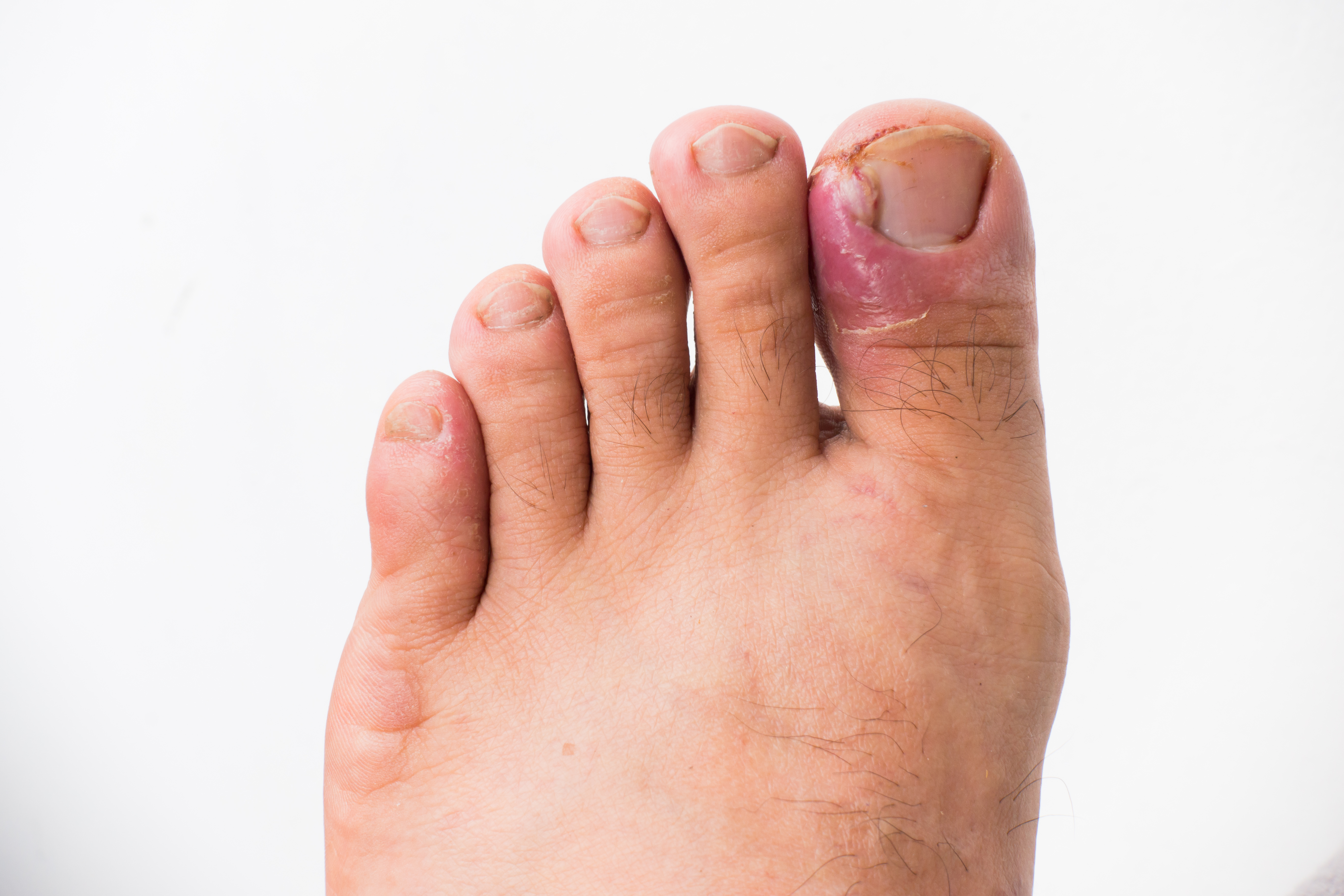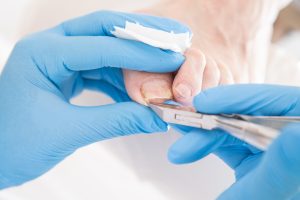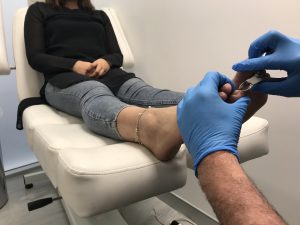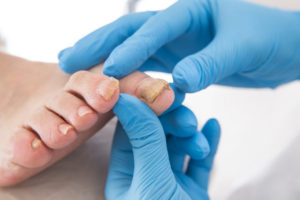
Ingrown toenails are painful and frustrating enough, so the last thing you want is to add an infection to the mix. Unfortunately, in our experience, a large number of ingrown toenails will get infected if proper treatment is undertaken – and it makes sense when you think about it.
Today, our ingrown toenail specialists will be sharing:
- Why the risk of developing an infection once you have an ingrown toenail is high
- What you can do to prevent an infection before it develops
- How you can treat your ingrown toenail and infection once it has occurred
You Have A Significant Risk Of Developing An Infection. Here’s Why
 Let’s clear something up: ingrown toenails and infections are not a case of the chicken and the egg – the ingrown toenail comes first.
What classifies a sore toe as an ‘ingrown toenail’ is the moment that the sharp piece of nail goes from merely pushing against the surrounding skin, to actually piercing it and penetrating it.
Think about that for a second – you have a piece of nail that is now constantly inside the skin through a cut down the side of the nail. Every time you walk and move, it’ll move slightly with vibrations of pressures from shoes and socks. Ouch! This also means that while a normal cut occurs and then can heal, this cut can’t – because the ingrown toenail is still constantly piercing it and so keeping the cut open.
An infection occurs when bacteria and other nasties enter the body. Usually, our skin is a fantastic barrier, so while there may be many nasties around us regularly, they never have an ‘in’. Until now. And especially at the ground where you may walk barefooted. And when you give it a perfectly placed entrance – there’s a strong chance that the infection will take hold and start to develop.
Once the infection takes hold, it means increased swelling, pain and oozy discharge (and maybe blood) that is yellow/green/clear in nature and may ‘crust over’.
Let’s clear something up: ingrown toenails and infections are not a case of the chicken and the egg – the ingrown toenail comes first.
What classifies a sore toe as an ‘ingrown toenail’ is the moment that the sharp piece of nail goes from merely pushing against the surrounding skin, to actually piercing it and penetrating it.
Think about that for a second – you have a piece of nail that is now constantly inside the skin through a cut down the side of the nail. Every time you walk and move, it’ll move slightly with vibrations of pressures from shoes and socks. Ouch! This also means that while a normal cut occurs and then can heal, this cut can’t – because the ingrown toenail is still constantly piercing it and so keeping the cut open.
An infection occurs when bacteria and other nasties enter the body. Usually, our skin is a fantastic barrier, so while there may be many nasties around us regularly, they never have an ‘in’. Until now. And especially at the ground where you may walk barefooted. And when you give it a perfectly placed entrance – there’s a strong chance that the infection will take hold and start to develop.
Once the infection takes hold, it means increased swelling, pain and oozy discharge (and maybe blood) that is yellow/green/clear in nature and may ‘crust over’.
Preventing An Infection From Your Ingrown Toenail Before It Develops
So how, then, can we prevent – or at least reduce the risk – of developing an infection? It’s quite simple, really. And no – no Epsom salts required just yet!
As the cut from ingrown toenail creates an ‘in’ for the bacteria to take hold, the way to prevent an infection is to remove this ‘in’. This means removing the penetrating nail edge so that the cut can heal, close, and no longer be vulnerable to the infection. Simple, right? – Absolutely.
So How Do I Treat My Ingrown Toenail – And The Infection If I Already Have One?
 The best way to ensure the proper care of your ingrown toenail is to see your Podiatrist. Our team here at the Ingrown Toenail Clinic are Podiatrists that are trained in simple and painless ingrown toenail surgeries, as well as conservative care where we safely remove that small, pesky nail edge in a matter of minutes. You’ll feel the relief almost instantly!
We don’t recommend trying to cut back the nail at home because often the nail runs much deeper than you can see, so most people will miss removing the complete penetrating edge and their pain will only continue to worsen. You also won’t have the right tools for the job – whereas we have everything needed to do it quickly and easily – even anaesthetic if you need or want it! (though most people don’t).
Once the sliver of nail is removed, the body will be able to effectively heal the wound and fight the infection – and of course, we’ll help it along by dressing it with betadine (antiseptic). You’re welcome to soak it in some Epsom salts too – but once the nail is out, it should be relatively simple and straightforward for it to heal and the infection to subside.
No more painful, swollen discharge – hooray!
The best way to ensure the proper care of your ingrown toenail is to see your Podiatrist. Our team here at the Ingrown Toenail Clinic are Podiatrists that are trained in simple and painless ingrown toenail surgeries, as well as conservative care where we safely remove that small, pesky nail edge in a matter of minutes. You’ll feel the relief almost instantly!
We don’t recommend trying to cut back the nail at home because often the nail runs much deeper than you can see, so most people will miss removing the complete penetrating edge and their pain will only continue to worsen. You also won’t have the right tools for the job – whereas we have everything needed to do it quickly and easily – even anaesthetic if you need or want it! (though most people don’t).
Once the sliver of nail is removed, the body will be able to effectively heal the wound and fight the infection – and of course, we’ll help it along by dressing it with betadine (antiseptic). You’re welcome to soak it in some Epsom salts too – but once the nail is out, it should be relatively simple and straightforward for it to heal and the infection to subside.
No more painful, swollen discharge – hooray!
Auckland’s Ingrown Toenail Experts
Perform Podiatry are proud to be home to the Auckland Ingrown Toenail Clinic – specialising in the safe and effective care of ingrown toenails – and we do a really good job of it! From simple and easy care to quickly remove the small nail edge, to minor nail surgery to permanently correct ingrown toenails, we’ve got you covered.
You can book online here or give us a call on (09) 523 2333.
We have the pleasure of seeing and treating a lot of ingrown toenails. That’s not sarcastic at all – successfully treating ingrown toenails provides an immense amount of relief to suffering patients and using our skills to do this successfully is something we’re very proud of.
There’s a common theme to many of the first visits we have with our patients, however, that we thought we’d shed some light on in case you happen to find yourself in this boat too. This theme is the I-googled-it-so-it-must-work home remedies for ingrown toenails.
Now, don’t get us wrong. Some of the strategies you try may well alleviate your pain and have you feeling much better. There’s almost always a catch though: It’s temporary.
Repeated ingrown toenail occurrence
The unfortunate truth is that if you’ve suffered from the terrible pains of ingrown toenails more than once, the reality is that you’re almost definitely going to suffer from them again. One-off ingrown toenails absolutely do occur, but the cause is usually a particular pair of tight shoes that push the nail into the skin and they don’t tend to occur again after you’ve stopped wearing them. Repetitive ingrown toenails are the best indicator that there’s something going on, that the nail has now started growing in an abnormal way that ends up penetrating the skin, and that it’s going to continue to happen.
So, why advise against home remedies?
The first reason is that without knowing exactly what you’re doing, you could be further encouraging the nail to continue to grow in a way that will cause you a tremendous amount of pain.
Take the way your nail is cut, for example. If you think that cutting down into the corner and removing the piece of nail will discourage it from growing there again – the reality is the exact opposite. Curving down and removing that painful nail edge will likely encourage the nail to keep curving a growing down – unless you know what you’re doing and understand the characteristics of nail growth.
The second reason is that as health professionals, we don’t want you to suffer with ongoing pain. Experiencing pain every 3 months from an ingrown toenail isn’t a great solution in our opinion, and especially not when you can have a one-time permanent procedure that will have you saying goodbye to ingrown toenails for good.
So, what is this procedure?
The procedure we’re talking about is called a partial nail avulsion (PNA). It involves removing a small part of the nail (the part that causes you pain!) and applying a chemical that will stop that small portion of nail from growing back and continuing to cause you grief, over and over again.
We love this procedure because:
 It’s done simply and effectively in-clinic
It’s done simply and effectively in-clinic- It’s completed in 60 minutes (with the procedure time typically around 20 minutes)
- It’s performed under local anaesthetic so is pain-free
- You do not need to take any additional time off work/school following the procedure & can go home immediately
- You don’t need any special boots or braces while the toe heals
- The procedure causes very little post-procedure discomfort
- We dress your toe, provide you with a take-home dressing pack & re-dressing instructions
- We monitor your progress to ensure it’s healing well
While we perform conservative one-off care for first-time ingrown toenails or those with a definitive cause that is not likely to recur, the PNA is our best recommendation for those that are repetitively putting up with and suffering from ingrown toenails. We have tremendous success with the procedure and have prevented hundreds of patients from continuing to regularly suffer. Our team are experts when it comes to ingrown toenails and we love seeing the difference that having this procedure makes in the lives of our patients.
For more information about the PNA procedure, click here. To book an appointment, you can give us a call on 09 523 2333 or book online.
 Let’s clear something up: ingrown toenails and infections are not a case of the chicken and the egg – the ingrown toenail comes first.
What classifies a sore toe as an ‘ingrown toenail’ is the moment that the sharp piece of nail goes from merely pushing against the surrounding skin, to actually piercing it and penetrating it.
Think about that for a second – you have a piece of nail that is now constantly inside the skin through a cut down the side of the nail. Every time you walk and move, it’ll move slightly with vibrations of pressures from shoes and socks. Ouch! This also means that while a normal cut occurs and then can heal, this cut can’t – because the ingrown toenail is still constantly piercing it and so keeping the cut open.
An infection occurs when bacteria and other nasties enter the body. Usually, our skin is a fantastic barrier, so while there may be many nasties around us regularly, they never have an ‘in’. Until now. And especially at the ground where you may walk barefooted. And when you give it a perfectly placed entrance – there’s a strong chance that the infection will take hold and start to develop.
Once the infection takes hold, it means increased swelling, pain and oozy discharge (and maybe blood) that is yellow/green/clear in nature and may ‘crust over’.
Let’s clear something up: ingrown toenails and infections are not a case of the chicken and the egg – the ingrown toenail comes first.
What classifies a sore toe as an ‘ingrown toenail’ is the moment that the sharp piece of nail goes from merely pushing against the surrounding skin, to actually piercing it and penetrating it.
Think about that for a second – you have a piece of nail that is now constantly inside the skin through a cut down the side of the nail. Every time you walk and move, it’ll move slightly with vibrations of pressures from shoes and socks. Ouch! This also means that while a normal cut occurs and then can heal, this cut can’t – because the ingrown toenail is still constantly piercing it and so keeping the cut open.
An infection occurs when bacteria and other nasties enter the body. Usually, our skin is a fantastic barrier, so while there may be many nasties around us regularly, they never have an ‘in’. Until now. And especially at the ground where you may walk barefooted. And when you give it a perfectly placed entrance – there’s a strong chance that the infection will take hold and start to develop.
Once the infection takes hold, it means increased swelling, pain and oozy discharge (and maybe blood) that is yellow/green/clear in nature and may ‘crust over’.
 The best way to ensure the proper care of your ingrown toenail is to see your Podiatrist. Our team here at the Ingrown Toenail Clinic are Podiatrists that are trained in simple and painless ingrown toenail surgeries, as well as conservative care where we safely remove that small, pesky nail edge in a matter of minutes. You’ll feel the relief almost instantly!
We don’t recommend trying to cut back the nail at home because often the nail runs much deeper than you can see, so most people will miss removing the complete penetrating edge and their pain will only continue to worsen. You also won’t have the right tools for the job – whereas we have everything needed to do it quickly and easily – even anaesthetic if you need or want it! (though most people don’t).
Once the sliver of nail is removed, the body will be able to effectively heal the wound and fight the infection – and of course, we’ll help it along by dressing it with betadine (antiseptic). You’re welcome to soak it in some Epsom salts too – but once the nail is out, it should be relatively simple and straightforward for it to heal and the infection to subside.
No more painful, swollen discharge – hooray!
The best way to ensure the proper care of your ingrown toenail is to see your Podiatrist. Our team here at the Ingrown Toenail Clinic are Podiatrists that are trained in simple and painless ingrown toenail surgeries, as well as conservative care where we safely remove that small, pesky nail edge in a matter of minutes. You’ll feel the relief almost instantly!
We don’t recommend trying to cut back the nail at home because often the nail runs much deeper than you can see, so most people will miss removing the complete penetrating edge and their pain will only continue to worsen. You also won’t have the right tools for the job – whereas we have everything needed to do it quickly and easily – even anaesthetic if you need or want it! (though most people don’t).
Once the sliver of nail is removed, the body will be able to effectively heal the wound and fight the infection – and of course, we’ll help it along by dressing it with betadine (antiseptic). You’re welcome to soak it in some Epsom salts too – but once the nail is out, it should be relatively simple and straightforward for it to heal and the infection to subside.
No more painful, swollen discharge – hooray!

 It’s done simply and effectively in-clinic
It’s done simply and effectively in-clinic